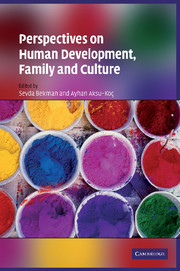Book contents
- Frontmatter
- Contents
- List of figures
- List of tables
- List of contributors
- Preface
- Foreword
- Selected international publications by Çiğdem Kağıtçıbaşı
- I Cultural and cross-cultural psychology: selected perspectives
- II Development in the family context
- III Culture and self
- IV Social change, family, and gender
- 13 One or two pathways to modernity? A systematic comparison of Kağıtçıbaşı's Model of Family Change and the Model of the Second Demographic Transition
- 14 Living together in culturally-plural societies: Understanding and managing acculturation and multiculturalism
- 15 Cultural continuity and discontinuity in Turkish migrant families: Extending the Model of Family Change
- 16 Values and attitudes of young people in urban Turkey: A further test of Schwartz's theory of values and Kağıtçıbaşı's Model of Family Change
- 17 Career development of professional women in Turkey
- V Induced change
- Epilogue
- Subject Index
- Author Index
- References
13 - One or two pathways to modernity? A systematic comparison of Kağıtçıbaşı's Model of Family Change and the Model of the Second Demographic Transition
Published online by Cambridge University Press: 04 August 2010
- Frontmatter
- Contents
- List of figures
- List of tables
- List of contributors
- Preface
- Foreword
- Selected international publications by Çiğdem Kağıtçıbaşı
- I Cultural and cross-cultural psychology: selected perspectives
- II Development in the family context
- III Culture and self
- IV Social change, family, and gender
- 13 One or two pathways to modernity? A systematic comparison of Kağıtçıbaşı's Model of Family Change and the Model of the Second Demographic Transition
- 14 Living together in culturally-plural societies: Understanding and managing acculturation and multiculturalism
- 15 Cultural continuity and discontinuity in Turkish migrant families: Extending the Model of Family Change
- 16 Values and attitudes of young people in urban Turkey: A further test of Schwartz's theory of values and Kağıtçıbaşı's Model of Family Change
- 17 Career development of professional women in Turkey
- V Induced change
- Epilogue
- Subject Index
- Author Index
- References
Summary
I got to know Çiğdem Kağıtçıbaşı on my first visit to Turkey in 1985, when trying to validate my empirical research on Turkish immigrant families in Germany in discussions with Turkish social scientists. This visit introduced me to the concept value of children, which thereafter became most influential to my academic work, both at the theoretical level, as it fitted well into modern sociological action theory and multi-level approaches, and in empirical research, as Çiğdem Kağıtçıbaşı's analyses were always at the interface of psychology and social sciences. During several encounters thereafter on various occasions, I felt much encouraged to take the initiative for a replication of the Value of Children (VOC) studies twenty five years later, which was the baseline for the following thoughts. I will always admire Çiğdem Kağıtçıbaşı for her ability to combine sharp analytical thinking with a humanitarian engagement for a civic society.
Introduction
Theorizing about the interrelationship between macro-social change and family structure has been a major feature of the various disciplines of the social sciences from their very beginning. In many cases, “family” was seen as the social group where the impact of social change could be understood in its greatest depth (Thornton 2005). Accordingly, the history of social sciences is full of examples of sequential models of social change and its consequences on family and kinship.
- Type
- Chapter
- Information
- Perspectives on Human Development, Family, and Culture , pp. 209 - 226Publisher: Cambridge University PressPrint publication year: 2009
References
- 1
- Cited by



